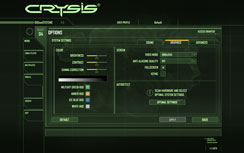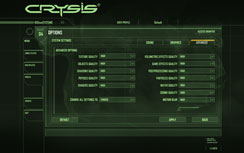HIS Radeon HD 4850 IceQ 4 TurboX 512MB
Written by Tim Smalley
October 3, 2008 | 07:38
Tags: #4850 #article #card #consumption #evaluation #fan #hd #iceq #iceq4 #noise #overclocking #performance #power #radeon #review #rv770 #speed #turbox

Crysis
Publisher: Electronic ArtsWhat can we say about this game that hasn’t been said already? Crysis was probably the most anticipated game on the PC last year and was released on November 16th 2007.
Crysis is seen by many as the poster boy for DirectX 10 and it will make your system cry, quite literally – it’s a monster! It doesn’t come as much of a surprise then, that the graphics are something special – they’re above and beyond anything we’ve ever seen in a PC game.
We tested the game using the 64-bit executable under both DirectX 9.0 and DirectX 10 with the 1.21 patch applied. We used a custom timedemo recorded from the Laws of Nature level which is more representative of gameplay than the built-in benchmark that renders things much faster than you're going to experience in game. We found that around 30-33 fps in our custom timedemo was sufficient enough to obtain a playable frame rate through the game. It's a little different to other games in that the low frame rates still appear to be quite smooth.
For our testing, we set all quality details to High and forced 8x Anisotropic Filtering in the driver menu as there is currently no support for it in game. We tested at 1280x1024, using 0x, 2x and 4x Anti Aliasing, 1680x1050 using 0x and 4x Anti Aliasing and 1920x1200 using 0x and 2xAA. By extensively testing using Anti Aliasing in very high resolutions, we'll be pushing even the bleeding edge hardware on test to the limit.
Crysis
1280x1024 0xAA 8xAF, DX9, High Detail
- ATI Radeon HD 4870 X2
- Nvidia GeForce GTX 280
- BFG Tech GeForce GTX 260 OCX Maxcore
- Zotac GeForce GTX 260 AMP!
- ATI Radeon HD 4870
- Nvidia GeForce GTX 260
- ATI Radeon HD 3870 X2
- HIS Radeon HD 4850 IceQ 4 TurboX
- Nvidia GeForce 9800 GTX+
- Powercolor Radeon HD 4850 PCS+
- ATI Radeon HD 4850
- Nvidia GeForce 8800 GT
-
-
78.6
-
35.0
-
-
-
56.0
-
33.0
-
-
-
55.0
-
32.0
-
-
-
50.9
-
30.0
-
-
-
45.9
-
26.0
-
-
-
45.8
-
27.0
-
-
-
44.2
-
21.0
-
-
-
39.5
-
22.0
-
-
-
39.0
-
23.0
-
-
-
37.9
-
21.0
-
-
-
36.3
-
20.0
-
-
-
30.5
-
18.0
-
0
10
20
30
40
50
60
70
80
Frames Per Second
-
Average
-
Minimum
Crysis
1280x1024 2xAA 8xAF, DX9, High Detail
- ATI Radeon HD 4870 X2
- Nvidia GeForce GTX 280
- BFG Tech GeForce GTX 260 OCX Maxcore
- Zotac GeForce GTX 260 AMP!
- Nvidia GeForce GTX 260
- ATI Radeon HD 4870
- ATI Radeon HD 3870 X2
- Nvidia GeForce 9800 GTX+
- HIS Radeon HD 4850 IceQ 4 TurboX
- Powercolor Radeon HD 4850 PCS+
- ATI Radeon HD 4850
- Nvidia GeForce 8800 GT
-
-
66.3
-
31.0
-
-
-
51.1
-
31.0
-
-
-
50.0
-
30.0
-
-
-
46.1
-
28.0
-
-
-
41.9
-
24.0
-
-
-
38.1
-
23.0
-
-
-
33.3
-
17.0
-
-
-
33.2
-
19.0
-
-
-
31.9
-
19.0
-
-
-
30.3
-
18.0
-
-
-
29.3
-
17.0
-
-
-
26.5
-
16.0
-
0
10
20
30
40
50
60
70
Frames Per Second
-
Average
-
Minimum
Crysis
1280x1024 4xAA 8xAF, DX9, High Detail
- ATI Radeon HD 4870 X2
- Nvidia GeForce GTX 280
- BFG Tech GeForce GTX 260 OCX Maxcore
- Zotac GeForce GTX 260 AMP!
- Nvidia GeForce GTX 260
- ATI Radeon HD 4870
- ATI Radeon HD 3870 X2
- HIS Radeon HD 4850 IceQ 4 TurboX
- Nvidia GeForce 9800 GTX+
- Powercolor Radeon HD 4850 PCS+
- ATI Radeon HD 4850
- Nvidia GeForce 8800 GT
-
-
63.4
-
33.0
-
-
-
48.3
-
29.0
-
-
-
46.9
-
28.0
-
-
-
43.6
-
25.0
-
-
-
39.6
-
23.0
-
-
-
36.7
-
22.0
-
-
-
32.7
-
17.0
-
-
-
30.4
-
18.0
-
-
-
30.2
-
17.0
-
-
-
28.9
-
16.0
-
-
-
28.0
-
16.0
-
-
-
24.2
-
14.0
-
0
10
20
30
40
50
60
70
Frames Per Second
-
Average
-
Minimum
Crysis
1680x1050 0xAA 8xAF, DX9, High Detail
- ATI Radeon HD 4870 X2
- Nvidia GeForce GTX 280
- BFG Tech GeForce GTX 260 OCX Maxcore
- Zotac GeForce GTX 260 AMP!
- ATI Radeon HD 4870
- Nvidia GeForce GTX 260
- ATI Radeon HD 3870 X2
- HIS Radeon HD 4850 IceQ 4 TurboX
- Nvidia GeForce 9800 GTX+
- Powercolor Radeon HD 4850 PCS+
- ATI Radeon HD 4850
- Nvidia GeForce 8800 GT
-
-
58.5
-
27.0
-
-
-
44.6
-
29.0
-
-
-
43.8
-
27.0
-
-
-
40.5
-
26.0
-
-
-
36.6
-
22.0
-
-
-
36.5
-
23.0
-
-
-
31.9
-
16.0
-
-
-
31.4
-
19.0
-
-
-
31.3
-
19.0
-
-
-
30.2
-
18.0
-
-
-
29.0
-
17.0
-
-
-
24.6
-
15.0
-
0
10
20
30
40
50
60
Frames Per Second
-
Average
-
Minimum
Crysis
1680x1050 4xAA 8xAF, DX9, High Detail
- ATI Radeon HD 4870 X2
- Nvidia GeForce GTX 280
- BFG Tech GeForce GTX 260 OCX Maxcore
- Zotac GeForce GTX 260 AMP!
- Nvidia GeForce GTX 260
- ATI Radeon HD 4870
- HIS Radeon HD 4850 IceQ 4 TurboX
- ATI Radeon HD 3870 X2
- Powercolor Radeon HD 4850 PCS+
- ATI Radeon HD 4850
- Nvidia GeForce 9800 GTX+
- Nvidia GeForce 8800 GT
-
-
46.8
-
23.0
-
-
-
38.4
-
25.0
-
-
-
37.2
-
24.0
-
-
-
34.6
-
22.0
-
-
-
31.5
-
20.0
-
-
-
28.0
-
17.0
-
-
-
23.8
-
15.0
-
-
-
23.5
-
10.0
-
-
-
22.5
-
14.0
-
-
-
21.9
-
13.0
-
-
-
19.9
-
11.0
-
-
-
16.6
-
9.0
-
0
10
20
30
40
50
Frames Per Second
-
Average
-
Minimum
Crysis
1920x1200 0xAA 8xAF, DX9, High Detail
- ATI Radeon HD 4870 X2
- Nvidia GeForce GTX 280
- BFG Tech GeForce GTX 260 OCX Maxcore
- Zotac GeForce GTX 260 AMP!
- ATI Radeon HD 4870
- Nvidia GeForce GTX 260
- ATI Radeon HD 3870 X2
- Nvidia GeForce 9800 GTX+
- HIS Radeon HD 4850 IceQ 4 TurboX
- Powercolor Radeon HD 4850 PCS+
- ATI Radeon HD 4850
- Nvidia GeForce 8800 GT
-
-
46.8
-
21.0
-
-
-
35.9
-
23.0
-
-
-
35.2
-
22.0
-
-
-
32.4
-
20.0
-
-
-
29.3
-
17.0
-
-
-
29.2
-
18.0
-
-
-
25.6
-
13.0
-
-
-
25.1
-
15.0
-
-
-
25.0
-
15.0
-
-
-
24.0
-
15.0
-
-
-
22.7
-
13.0
-
-
-
19.9
-
11.0
-
0
10
20
30
40
50
Frames Per Second
-
Average
-
Minimum
Crysis
1920x1200 2xAA 8xAF, DX9, High Detail
- ATI Radeon HD 4870 X2
- Nvidia GeForce GTX 280
- BFG Tech GeForce GTX 260 OCX Maxcore
- Zotac GeForce GTX 260 AMP!
- Nvidia GeForce GTX 260
- ATI Radeon HD 4870
- HIS Radeon HD 4850 IceQ 4 TurboX
- Nvidia GeForce 9800 GTX+
- Powercolor Radeon HD 4850 PCS+
- ATI Radeon HD 4850
- ATI Radeon HD 3870 X2
- Nvidia GeForce 8800 GT
-
-
38.9
-
18.0
-
-
-
32.6
-
20.0
-
-
-
31.5
-
20.0
-
-
-
29.2
-
19.0
-
-
-
26.6
-
17.0
-
-
-
23.7
-
15.0
-
-
-
19.8
-
12.0
-
-
-
18.9
-
10.0
-
-
-
18.8
-
11.0
-
-
-
18.1
-
11.0
-
-
-
17.5
-
6.0
-
-
-
15.5
-
9.0
-
0
10
20
30
40
Frames Per Second
-
Average
-
Minimum
Using Crysis' DirectX 9.0 mode yields some frame rate improvements that are largely thanks to the improved driver maturity, but playability is unlikely to improve vastly. You may be able to squeeze 1,680 x 1,050 2xAA out of the HIS Radeon HD 4850 IceQ 4 TurboX, but you're not going to manage 4xAA without making some fairly big compromises to the in-game quality settings.
It's a fairly close fight between this and Nvidia's GeForce 9800 GTX+ - both are around seven percent faster than the stock-clocked Radeon HD 4850. The 4870 and GTX 260, on the other hand, are both able to push playability right up to 1,920 x 1,200 0xAA, where the two are fairly evenly matched.











Want to comment? Please log in.